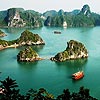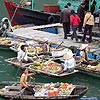Vietnam Tours

Lying on the eastern part of the Indochinese peninsula, Vietnam is a strip of land shaped like the letter "S". China borders it to the north, Laos and Cambodia to the west, the East Sea to the east and the Pacific Ocean to the east and south. The country's total length from north to south is 1,650km. Its width, stretching from east to west, is 600km at the widest point in the north, 400km in the south, and 50km at the narrowest part, in the centre, in Quang Binh Province. The coastline is 3,260km long and the inland border is 4,510km.

Vietnam is located in both a tropical and a temperate zone. It is characterized by strong monsoon influences, but has a considerable amount of sun, a high rate of rainfall, and high humidity. Regions located near the tropics and in the mountainous regions are endowed with a temperate climate.

Three quarters of Vietnam's territory consists of mountains and hills. Vietnam is divided into four distinct mountainous zones. Because of so, Vietnam has a variety of mineral resources. Located beneath the subsoil are precious stones, coal and valuable minerals such as tin, zinc, silver, gold and antimony. Vietnam also has large deposits of oil and gas on its offshore islands and on the mainland. Vietnam also has abundant subterranean mineral water sources. These are found at Quang Hanh in Quang Ninh, Hoi Van in Binh Dinh, Vinh Hao in Binh Thuan, Duc My in Nha Trang, Kim Boi in Hoa Binh, and Binh Chau in Ba Ria -Vung Tau.

Vietnam is the proud recipient of three World Heritage Site cultural awards: the Imperial City of Hue; Hoi, an ancient town trade center; and, My Son holy land. Other cultural attractions include the capital city of Hanoi, dubbed the “Pearl of the Far East” Ho Chi Minh City (formerly known as Saigon), the town of Sapa, the village of Mai Chau, and many others.
Vietnam's attractions also come from its landscape with virgin beaches and islands, unspoiled mountains and forests, hundreds of beautiful lakes, rivers, waterfalls, and many unforgettable caves. Vietnam's coastline features endless stretches of empty, white sand beaches. The most famous is World heritage Halong bay, with thousands of islands and rocks of different sizes and shapes. You also may enjoy at one of more than 20 beautiful resorts along the coastline, such as Tra Co, Cat Ba island in the north and Da Nang, Nha Trang, in the Middle, Vung Tau, Con Dao island and Phu Quoc island in the south.


